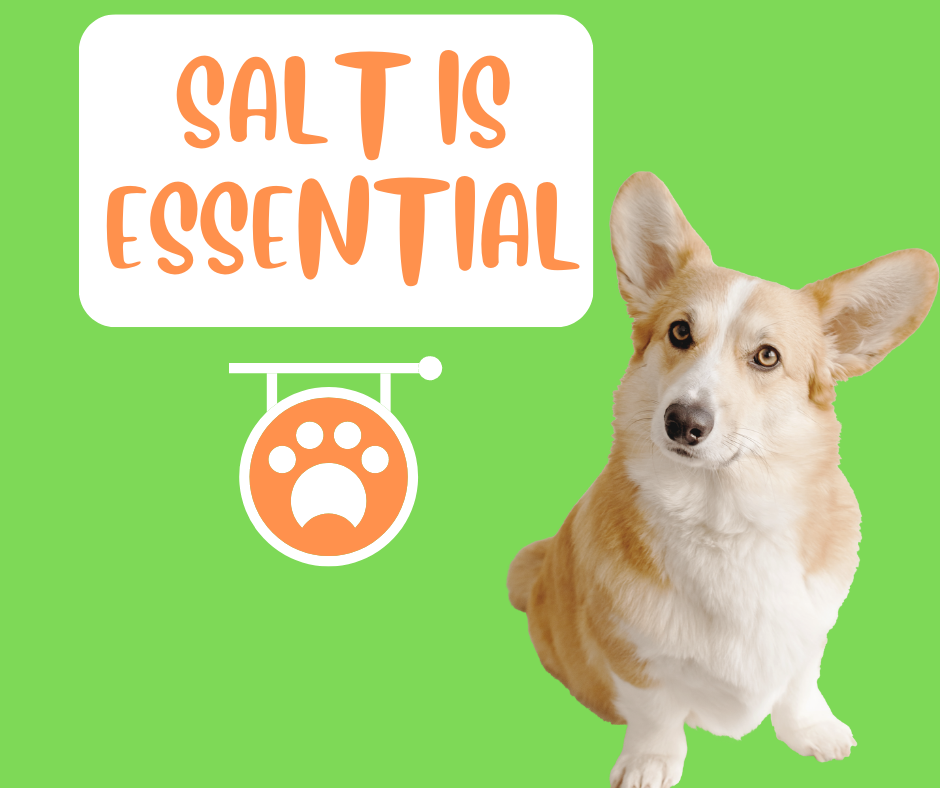
Salt. It’s a simple four letter word, but it has multiple facets to consider, including:
- How it’s used in the body.
- Why we like to eat it.
- How Salt affects certain conditions of health or ill health. Because there’s some confusion out there.
Let’s start with a simple definition. What is salt? It could be a simple chemical formula of sodium and chloride called NaCl. You can talk about table salt, iodized salt, Himalayan salt, Celtic sea salt, Redmond salt. There are a lot of kinds of salt. (Actually, there are a whole bunch of chemical salts, but that’s not what we’re talking about here. We’re talking about the salt that goes into our food.)
So we all know what salt is, but too few people are knowledgable anymore on why the body needs salt in the first place. So let me ask you: what does our body use salt for?
Let me give you a couple of examples, which I learned from Dr. Cathy, so this applies to both humans and pets:
What does your sweat taste like? Salt. What do your tears taste like? Salt. Every. Single. Cell. In your body talks to the cell next door using a sodium/potassium pump. Sodium. The Na part of NaCl. (If you wanted to get all science-ey, potassium is also found in a salt form, potassium chloride. KCl. But that’s not really the topic today.)
Every single cell in your body regulates its volume using salt. Kidneys use salt to evaluate how much fluid to keep in the body how much fluid to put out. Muscles use salt to contract.
But what about the heart? The heart is a muscle! The heart requires salt to contract, and it requires salt to make the electrical signal that causes a heartbeat (just saying, but that heartbeat is essential for life).
Nerves use salt. Nerves use salt to send the electrical signal down the line to the next nerve. we couldn’t move without salt.
Every single cell in the body uses salt!
Every
Single
Cell
Every single cell in the body uses salt!
Every
Single
Cell
So, why do humans like to eat it? Two reasons. One is for taste and two is because, as was just discussed above, our bodies crave salt because it is essential to our survival.
You’re right, I just said humans. But I’m a dog and that’s what you’re here to learn more about: pet nutrition. So let’s talk dogs and cats.
I want you to go to the pantry and look at that ingredient list of that kibble you are feeding your pet. There’s more salt in there than vitamins and minerals! There is a whole lot of salt in conventional pet food! Why? Three reasons. One it taste good. Two dogs and cats bodies are mammals just like humans and they need salt also. And three, because kibble is so dry that the manufacturers put extra salt in there so that dogs and cats guzzle water to reconstitute the kibble in the intestines!
Basically the manufacturers are driving dogs and cats to drink extra water so that the kibble will swell in the stomach and the body will try to digest this highly overprocessed over salted “food“.
Yuck.
So where is today’s science lesson coming from? WHY did Dr. Cathy just school me on SALT?
Way back in the 1950s in human medicine the “advice“ to heart patients was to tell them to eat a low/no salt diet. So humans would become over-compulsive and not eat any salt at all. Which then led to kidney issues (frequent urination, or not urinating enough), water metabolism issues (the ever common swollen ankles), problems regulating body temperature (sweating profusely while not moving at all); things got out of balance. So what the advice really is is “don’t eat fried, salty, junk food“!
Well, human medicine has started to come around. Human medicine is starting to recommend reduced salt intake but not none.
Veterinary medicine seems to be 20 years behind, in the US at least. I’ve heard several cases in the last month where it’s recommended that animals eat a “no salt diet”!
Enter: Dr. Cathy’s lesson on the importance of salt.
I realize part of the issue is that the medical recommendation has been “low salt“ and the humans are taking it to an extreme and changing those words and calling it “no salt“. But ultimately, the problem is that people don’t understand nutrition! (It’s not their fault.) (And, instead of simply saying “low salt”, it would help the pet owner a lot if the veterinarian said what that looks like. Like: avoid conventional, highly processed foods that are over salted.
But that would really mean recommending fresh food and not the conventional “prescription“ diets being sold in the veterinary clinic. OK. I get it. Frustrating.) This is basic physiology.
Sure, maybe every pet owner hasn’t had basic physiology. But every single veterinarian, veterinary technician, chiropractor, human physician, nurse, acupuncturist, physical therapist, healthcare provider, you name it, has this basic physiology the first year of whatever healthcare school they went to.
Okay, science lesson is done.
Okay, science lesson is done.
How about a little take-home message for healthy diets for dogs and cats?
- Salt is not poisonous in normal, lightly seasoned amounts. The body needs salt.
- So don’t avoid it like the plague. And don’t go the other direction and over-use it.
- And when you are reading the ingredient list of a pet food, look how many “nutrients” come after the salt in the list.
Consider a fresh food diet. There’s nowhere near as much salt in fresh food. And if you make your own, there are many ways to come up with a balanced diet. And it does include a tiny little bit of salt.
